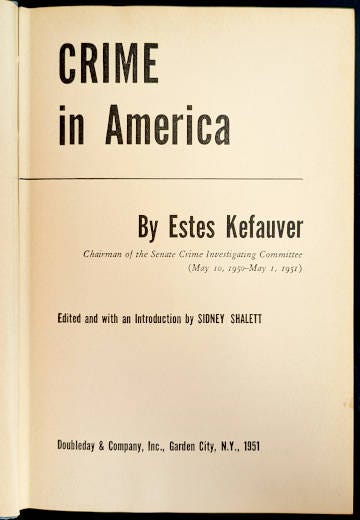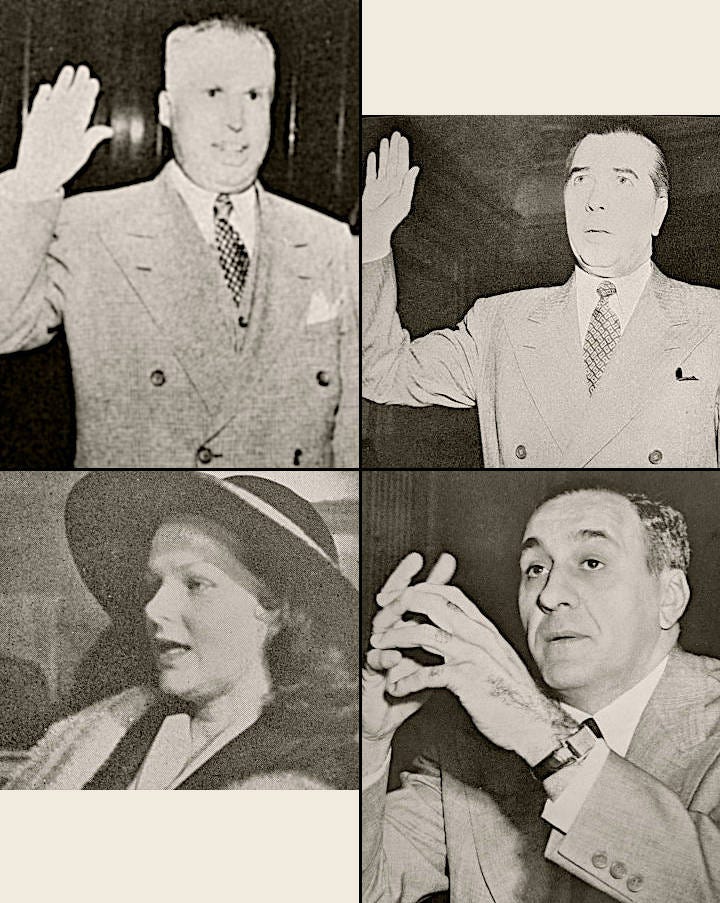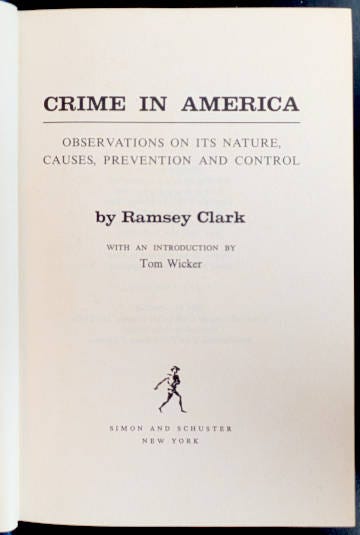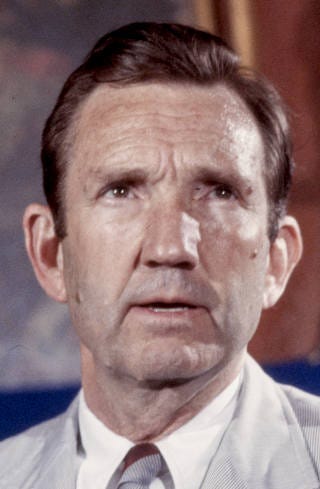Same titles, very different books
‘Crime in America’ may or may not be the book you're looking for
You’re interested in learning about crime in America? Well, there are two1 fairly well known books about historic lawlessness and the efforts of law enforcement in the United States, both written by fairly well known authorities on the subject and both using precisely the same title, Crime in America. But they are two very different books.
Crime in America by Estes Kefauver, edited by Sidney Shalett.
Back in 1951, Doubleday & Company released Crime in America authored by U.S. Senator Estes Kefauver (D-TN).2
Carey Estes Kefauver (1903-1963) had been the chairman of the Senate Special Committee to Investigate Crime in Interstate Commerce, a rambling name that was generally shortened to “Kefauver Committee.” Formed in the spring of 1950 to explore the misuse of interstate commerce and communication by criminal networks, the committee did groundbreaking work in exposing connections among regional gangs and their corruption of legitimate enterprises and law enforcement agencies. Originally set to terminate on March 31, 1951, the committee’s life was extended until September 1, 1951. Hearings were conducted in major cities across the U.S. and were broadcast on the relatively new medium of television. In addition to many volumes of transcribed testimony, the committee released three interim reports - August 1950, February 1951, May 1951 - and one final report in August 1951.

Kefauver's published book, based on information revealed in committee hearings into interstate organized crime up to May 1, 1951, was surely written in support of the committee's legislative priorities, but it may also have been written in anticipation of Kefauver's (ultimately unsuccessful) run for the Democratic Presidential nomination in 1952.
Kefauver's single-book summary of his committee's investigations is particularly interesting and useful to organized crime historians. The truth of this can be verified in the table of contents:
Birth of the Crime Committee.
The Mafia and Lucky Luciano.
The Wire Service: Public Enemy Number One.
Chicago: The Heritage of Al Capone.
Greasy Thumb, The Enforcer, and Some Chicago Politicians.
Corruption of a Small Town: A Case Study.
Miami: Polluted Playground.
Tampa: The Strange Domain of a Sheriff Called 'Melon Head.'
How to Turn Brass into Gold: The Black Market and Business Infiltration Story.
Kansas City: Law of the Jungle.
The St. Louis Area: Where Gambling is Big Business.
Louisiana: Fantasia in Law Enforcement.
The Cleveland Area: 'Middletown' of Crime.
Detroit: Where Underworld and Business World Merge.
Philadelphia: Police Tactics in the City of Brotherly Love.
Nevada: A Case against Legalized Gambling.
California: Where Lobbyists Grow Big and Mobsters Thrive.
How the Laws are Enforced in Upstate New York.
Costello & Co., and an Embattled Ambassador.
How the National Crime Syndicate Can Be Smashed.
The book begins with an introduction by Sidney Shalett, who is also listed as the book’s editor. This is as much an introduction to Estes Kefauver as it is an introduction to the subject of organized crime, and it finishes by making a case for Kefauver as President. Shalett (1911-1965), born in Stamford, Connecticut, began his writing career in 1930 as a reporter with the Chattanooga Times (giving him a Tennessee connection with Kefauver). From the later 1930s through the end of World War II, he worked for the New York Times, serving in its London and Washington bureaus. He became a freelance writer in 1947, and had his articles published in such periodicals as the Saturday Evening Post and Harper's. He also worked at American Magazine and U.S. News and World Report. His other well-known book project was Affectionately, F.D.R., which he coauthored with James Roosevelt, son of President Franklin Roosevelt. That book was released in 1959.
Kefauver's Crime in America includes a good number of photographs relating to its subject. In addition to photos of committee members and staff (including a full page shot of committee Chief Counsel Rudolph Halley), there are images of Anthony Accardo, Louis Campagna, Al Capone, Mickey Cohen, Frank Costello (multiple photos), Joseph DiGiovanni, Joe “Adonis” Doto, Frank Erikson, Anthony Gizzo, Jacob Guzik, Virginia Hill (multiple photos), Morris Kleinman, James Licavoli, Salvatore “Charlie Luciano” Lucania, Carlos Marcello, Paul Ricca and Abner “Longie” Zwillman.
I am sorry to report that an index is not included in the work, which contains 333 numbered pages.
Crime in America: Observations on its Nature, Causes, Prevention and Control by Ramsey Clark.
In 1970, not quite two decades after Kefauver's book, Simon and Schuster released Crime in America by former U.S. Attorney General Ramsey Clark.3
William Ramsey Clark (1927-2021) served in the United States Justice Department during the John Kennedy Administration and became head of the department late in the Lyndon Johnson Administration from 1967 to 1969. He was a leading figure in the fight for civil rights and oversaw the drafting of the Civil Rights Act of 1968. Clark went into the private practice of law after leaving the DOJ, but he remained in the public eye, delivering speeches about crime and law enforcement across the country and authoring this one book. While Ramsey Clark was never a serious Presidential candidate like Estes Kefauver, he won a single vote for the Presidential nomination at the 1972 Democratic Convention (George McGovern became the party nominee), and he won two votes to be the Vice Presidential nominee in largely chaotic balloting at that convention. Clark ran two unsuccessful campaigns during the 1970s for a New York seat in the U.S. Senate.
Organized crime was not Clark's priority. He was less interested in documenting cases of outlaw networks and official corruption than in exploring the root causes of criminal behavior and the institutional blindness to those causes. The table of contents of his book (with 20 numbered chapters, just as in Kefauver’s book) follows:
Change and Crime.
The Many Faces of Crime.
The Crime Count: Ignorance, Myth and Fact.
The Mother of Crime.
Organized Crime: The Limited Empire.
Drugs: When Chemistry and Anxiety Meet.
Guns: The Violent Killers.
The Failing System.
Police: The Urgent Need to Professionalize.
Servants or Oppressors?
Police in Times of Turbulence.
Courts and Prosecutors: Breakdown and Reform.
Prisons: The Factories of Crime.
The Young, the Powerless and Dissent: New Frontiers for the Social Compact.
Technology: The Promise and the Peril.
Soldiers, Safety and Freedom.
The Wiretap: Destroyer of Integrity.
Presumed Innocent? Bail and Preventive Detention.
Confessions, the Fifth Amendment and Human Dignity.
The Death Penalty and Reverence for Life.
(Plus: Epilogue: A Passion for Justice.)
Read and interact with our short-form content in Substack Notes.
His book begins with an introduction by Tom Wicker (1926-2011), reporter and columnist for the New York Times. Wicker described Clark’s background and summarized Clark's view of crime and its causes. He repeated Clark's view that the vast majority of the criminal activity in U.S. cities occurred in isolated pockets of despair and poverty.
Clark's book does not entirely ignore organized crime. The author devoted the sixteen and a half pages of Chapter 5 to the topic. While recognizing the serious dangers of racketeering-related corruption, Clark felt that the impact of organized crime on American society had been exaggerated: “We must not deceive ourselves - organized crime is a very small part of America's crime.” He suggested that America had begun to win its war against traditional organized crime, partly through the attention of federal law enforcement beginning in the late 1950s and early 1960s and partly through the gradual erosion of the underlying principles of “La Cosa Nostra”:
There is no reason why La Cosa Nostra should not be relegated to history within a few years. It is on the ropes now. (p. 82)
There are no photographs in Clark's Crime in America and also no index. It contains 346 numbered pages.
There is at least one other less well known book with the same title.
Kefauver, Estes, Crime in America, Garden City, NY: Doubleday & Company, 1951.
Clark, Ramsey, Crime in America: Observations on its Nature, Causes, Prevention and Control, New York: Simon and Schuster, 1970.













